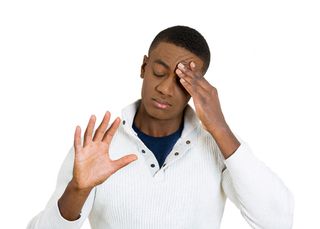
Many Small Microaggressions Add Up to Something Big

This article was originally published at The Conversation. The publication contributed the article to Live Science's Expert Voices: Op-Ed & Insights.
Upon entering a classroom or office for the first time, I frequently take more than a few seconds to place my book bag on the floor. I do this to give the occupants of the room the opportunity to brush aside all assumptions they may have made before meeting me, their professor or invited guest. Inevitably, though, some soul will make a comment like “I didn’t quite expect you when I talked to you on the phone,” “registered for this course,” or some other seemingly innocent remark.
These innocuous-on-the-surface comments are examples of microaggressions. They allow the expression of biased opinions while freeing the aggressor by means of a thin veil of doubt: was that action, comment or behavior intentional? Often microaggressions take the form of unconsciously delivered instances of failing to acknowledge or making light of the experiences of others from different cultures, traditions, races – and they’re easily justified or ignored. These are subtle messages that leave the recipient doubting whether they occurred at all and how to respond.
The term was first used to describe subtle communications of expectations and stereotypes associated with race. It’s in this context that the idea of microaggression is being discussed now amid racial tensions on campuses across the United States. Usage has evolved to also include those who’ve traditionally been marginalized, such as women and people living with disabilities. Whether conscious or unconscious, microaggressions are acts that silence or minimize those with less power. What might seem to be no big deal to the more powerful actor can have long-lasting, damaging effects on a recipient who has to deal with these kinds of marginalizing expressions on a daily basis.
Three forms of microaggressions
Think of some male-occupied spaces where misogyny is carried out without anyone batting an eye. There are many similarly homogeneous spaces – heterosexual, Christian, American, able, middle-class. Within them, there’s a norm and those who are different are sometimes referred to in terms that don’t leave these spaces unless the speaker has lost control, is hidden behind the screen of the internet or is truly ignorant.
Though debatable, some would argue that we now live in a post-racial society where explicit racist comments and imagery are rarely tolerated. Microaggressions are instances when these kinds of biased thoughts become apparent in the wider culture.
Microassaults are verbal or nonverbal communications that typically convey insensitivity or rudeness. Examples would be using a derogatory racial slur, displaying a Confederate flag or posting images demeaning to women in a public area to be seen by all.
Sign up for the Live Science daily newsletter now
Get the world’s most fascinating discoveries delivered straight to your inbox.
Microinsults are subtle messages that convey to the recipient that their presence would not have been possible were it not for preferential treatment. Often these comments are couched in the form of questions that appear to be legitimate. Think about asking a female student to explain her admission to a prestigious math or science program. Though not overtly aggressive in nature, the surprise implicit in the question implies that the student’s record of achievement is unexpected or not comparable with that of her peers. In addition to verbal comments, microinsults are behavioral in nature – clutching a purse or exiting an elevator at the sight of a man of color constitute microinsults.
Microinvalidation removes the receiver from her experiences. For example, the perpetrator may assert that he is colorblind, that a person’s racial background is not important to him: “I don’t care if you are black, white or purple.” As with microinsults, these comments may not be hostile in intent. However, they reject the receiving individual’s experiences in a decidedly non-colorblind world, while relieving the perpetrator of any responsibility for authentic engagement with the invalidated other. And frankly, I think you should care if I were purple.
While ignorance of how something will be received is not an excuse for what can be less-than-conscious acts, more damning is the dismissal of the recipient’s perception. Often the microaggression’s recipient is told, “You’re too sensitive,” or “Stop being politically correct.” In these moments, a thoughtful interaction concerning intention and perception would further our communal growth. Typically, though, two bruised fighters return to their own corners.

Microaggressions, macro impacts
Each individual instance of microaggression represents a missed opportunity for mutually enriching engagement. But worse, people who are frequently on the receiving end of microaggression experience ongoing psychological distress that can have long-term impacts.
For example, one study found almost 40 percent of 174 African-American doctoral students and recent PhD graduates – a high-achieving group – reported being treated rudely or disrespectfully within the last year; 30 percent indicated that their ideas or opinions were minimized, ignored or devalued or that they have been ignored, overlooked or not given service; 26 percent stated that they had not been taken seriously; another 22 percent stated they’d experienced being considered fancy or exotic by others. The researchers found high experiences of underestimation of personal ability were related to elevated levels of perceived stress.
When encounters commonly come with subtly denigrating messages, recipients use substantial mental energy dealing with the incidents and figuring out how to respond.
Remember my personal example of the surprise some people voice when I walk to a lecture hall’s podium. Instead of just getting ready to teach, I have to deal with their comments, internally or publicly. I feel responsible for helping the speaker release their notions of what a policy and research professor – or someone with the surname Van Sluytman, for that matter – looks like, or how a black man sounds on the phone.
I feel challenged to validate my experiences, and question both my privilege and my marginalization. And I feel obligated to validate the experience and presence of all others who have ever stood or will stand in my place facing the subtle message that they’re not what or where they’re expected to be. They do not belong. There are limits to their possibilities. But I know that we are not all equally equipped to run this gauntlet; some will not survive.
Beyond the personal effects, the stress associated with repeated exposure to intentional and unintentional microaggression may erode an individual’s willingness to engage with the larger society. Perhaps this is the goal of microaggressors – an erasure of those who represent difference. But that’s not realistic.
Instead, in tandem with other forms of institutional discrimination, the repeated onslaught of microaggression and the effort to resolve the resulting emotions can lead to negative results for the recipient groups. In addition to psychological distress, those who retreat face the possibility of reducing the support they need to develop maximum self-confidence, as well as the networks that enhance the group’s economic and social status while reducing the risks for poverty.
The matter at hand and the way forward
For the students of University of Missouri, Yale and other learning centers, active engagement is a requirement of success. The tacit restrictions – no longer marked by Jim Crow-era signs – subvert the goals of the institution: educational attainment and the individual’s subsequent capacity to participate in the global community. In university mission statements across the United States, student growth is a pillar of institutions. These pillars support the campus environment and the future of the communities to which students belong. Microaggression against students renders them less likely to participate in the richness that campus life has to offer. It strips them of the ability to build networks that would enhance their communities.
While Americans have elected their first African-American president and Hillary Clinton seems poised to shatter that highest, hardest glass ceiling, many Americans struggle to accept the plurality of the country’s population with regard to gender, ethnicity, sexual orientation and race. Members of minority communities continue to face disparities in health outcomes, incarceration and unemployment and earnings, among other negative outcomes. They face microaggressions that challenge confidence and diminish their capacity to engage needed systems and services, and leave us in much more impoverished world.
We must acknowledge that each person’s experience is of value though it may be distinct from our own. Being present and mindful could lead to reducing microaggressions that seek to dismiss, devalue or destroy the vibrant diversity that is American society. Be open to the possibility that your Chinese classmate was born and raised in Santa Monica. Commenting on her unaccented English is not a compliment. It positions her as a constant outsider, never truly American. The way forward depends on our ability to embrace our society’s plurality.
Laurens Van Sluytman, Assistant Professor of Social Work, Morgan State University
This article was originally published on The Conversation. Read the original article. Follow all of the Expert Voices issues and debates — and become part of the discussion — on Facebook, Twitter and Google +. The views expressed are those of the author and do not necessarily reflect the views of the publisher. This version of the article was originally published on Live Science.
Most Popular


